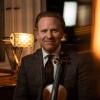
Daniel Hope may be putting “a girdle round about the earth” with his violin (to borrow the words of another Britisher, Shakespeare in A Midsummer Night’s Dream), but next season, Hope will once again pause his peregrinations long enough to bring varied and appealing music to the Bay Area.
New Century Chamber Orchestra, where Hope has been music director since 2018, has just announced the details of its 2024–2025 season, which cuts a wide swath through periods, genres, instruments, and moods in 16 performances of five programs.
“The season ahead is one of our most diverse yet, with a tremendous variety of classics and new works, often juxtaposed in provocative and moving ways,” says Hope.
“In the same program, you can hear one of the greatest pieces for strings ever written, [Richard] Strauss’s Metamorphosen, together with the new commission by Jungyoon Wie — the two talking across time to tell stories about peace. Musical storytelling is a hallmark of New Century, as is the dynamic energy that is palpable between our 19 string musicians who play standing together without a conductor, deep in communication with each other and showcasing their love of the music. This is chamber music on a grand scale.”

In addition to NCCO’s regular venues — Berkeley’s First Congregational Church, San Francisco’s Presidio Theatre, and St. Stephen’s Episcopal Church in Belvedere — the orchestra also performs next year at Sonoma State University’s Green Music Center and Stanford’s Bing Concert Hall, among other locations.
The season opens Nov. 14–17 with encore performances of a past sensation for Hope and NCCO, Vivaldi: Recomposed, Max Richter’s reimagining of Antonio Vivaldi’s The Four Seasons, recorded for Deutsche Grammophon in 2012 with Hope as soloist and first performed by NCCO in 2019.
The 2012 recording topped classical charts in 22 countries, has been streamed more than 500 million times, and has been used as the soundtrack for numerous TV and film projects, including the hit series The Crown and Bridgerton.
Those first NCCO concerts also include the Allegro Moderato from Samuel Coleridge-Taylor’s Four Novelletten for String Orchestra and another recomposition: the U.S. premiere of British composer David Bruce’s Lully Loops for violin and string orchestra.
Bruce’s piece uses brief sequences from works by Jean-Baptiste Lully, infusing the music of the Baroque with shimmering contemporary flourishes. Lully Loops was commissioned by Hope’s Zurich Chamber Orchestra, which performed the piece’s world premiere last year. “This piece is so visceral and energetic,” says Hope. “Audiences have been riveted in Europe, and I truly think it’s a masterpiece.”

2025’s opening concerts, Jan. 17–19, feature “musical diversions”: C.P.E. Bach’s Keyboard Concerto No. 3, Dmitri Shostakovich’s Piano Concerto No. 1, and Béla Bartók’s Divertimento for String Orchestra. Inon Barnatan is the pianist in both concertos, the latter also featuring San Francisco Symphony associate principal trumpet Aaron Schuman. Hope says the Shostakovich “is a dazzling show of virtuosity and always brings the house down.”
March 6–9, 2025, NCCO joins harpist Brandee Younger, an SFJAZZ resident artistic director, in her new works paying tribute to Alice Coltrane, Dorothy Ashby, and Younger’s teacher, Jackie McLean. These concerts are all held at the SFJAZZ Center.
The concerts April 4–6, 2025, are named after San Francisco-based composer Jungyoon Wie’s A Prayer for Peace. This NCCO co-commission (with Boston’s A Far Cry chamber orchestra) represents the composer’s journey as a Korean immigrant to the United States. “There are beautiful harmonies but also very arresting emotions throughout the piece,” says Hope. “Jungyoon has a very [distinctive] voice, and we are excited to be working with her.”
The program opens with Adolphus Hailstork’s Sonata da Chiesa and closes with Strauss’s Metamorphosen — his late-in-life string masterpiece composed in the ruins of Germany at the end of World War II, which is both a memorial for the victims of war and a call to rebuild after tragedy. The layered work, with its 23 individual solo parts, has long been considered one of the most brilliantly constructed pieces for string orchestra.
The season-closing concerts, May 1–4, 2025, feature selections from Hope’s album Dance!, leading audiences through the history of 700 years of Western dance music. From Baroque opera and Russian ballet to klezmer and tango, this program illuminates the universal nature of dance rhythms that have set bodies in motion and lifted spirits for centuries.
Highlights include selections from Handel’s Water Music, the Pas de Deux from Tchaikovsky’s Swan Lake, Jacques Offenbach’s iconic Can-Can from Orpheus in the Underworld, Franz Schubert’s Five German Dances, and Danse Macabre by Camille Saint-Saëns, as well as works by Florence Price, Astor Piazzolla, and many more.
“I have been thinking about a dance album since 1999,” says Hope. “But after the pandemic lockdowns, it really felt like there was an urgent need to express movement and reflect on collective enjoyment. The album says as much about us as human beings as it says about dance music. I’m excited to share selections from it for the first time in the Bay Area.”




